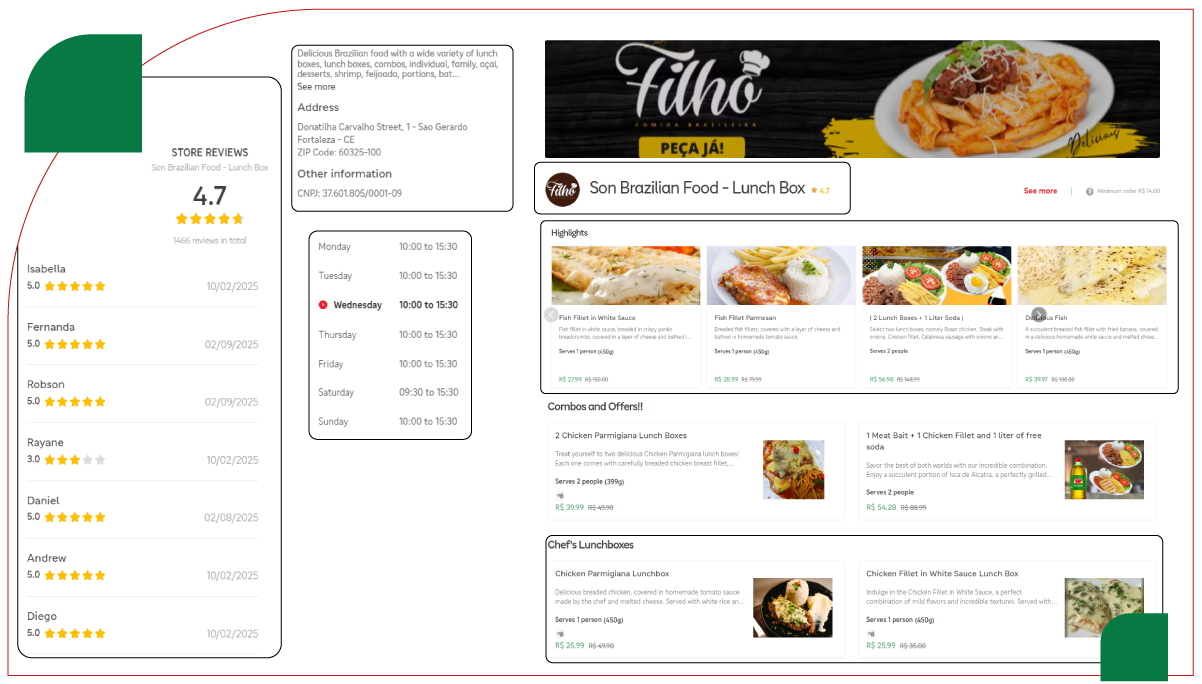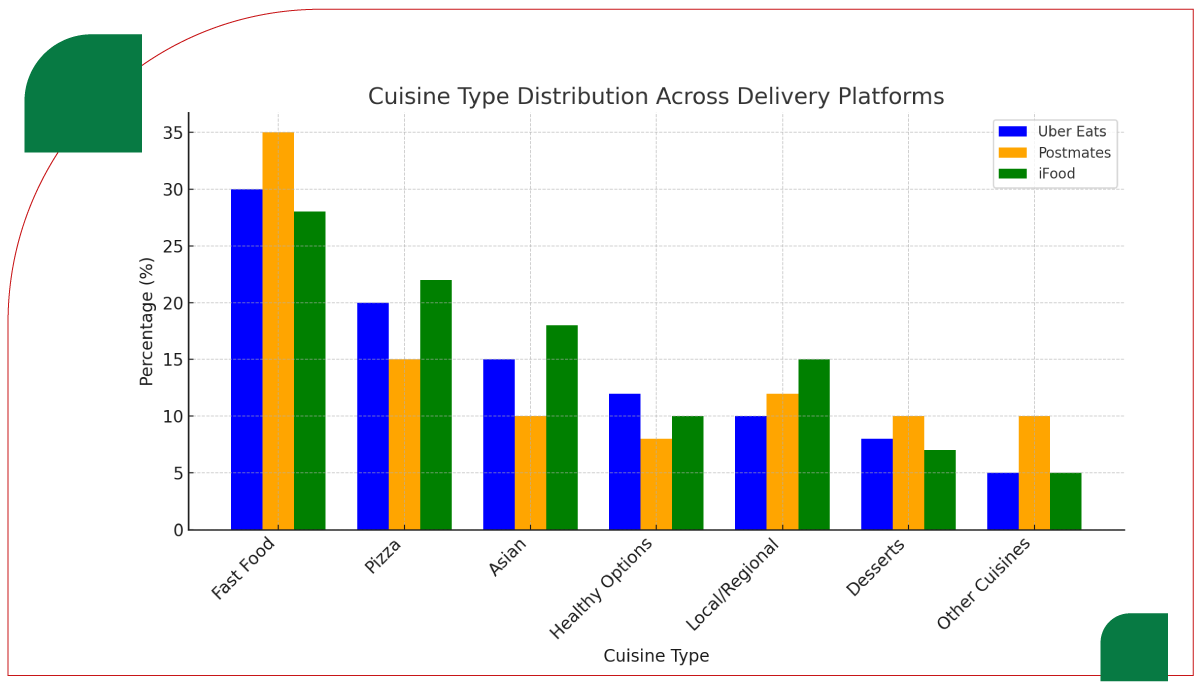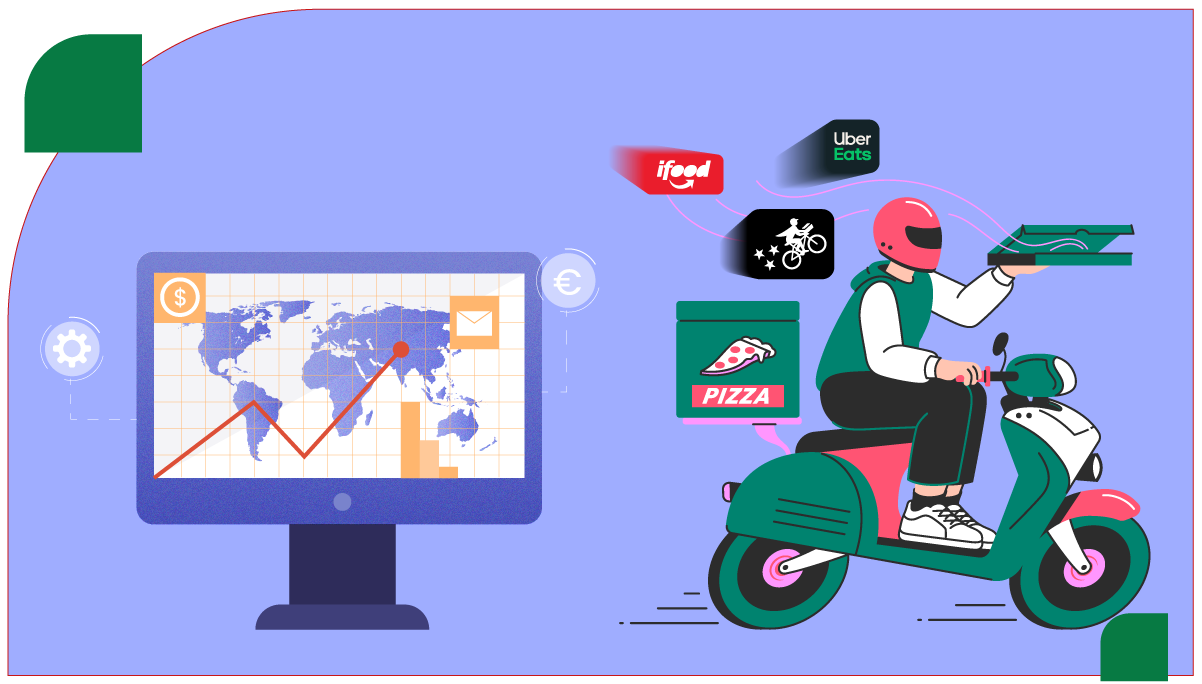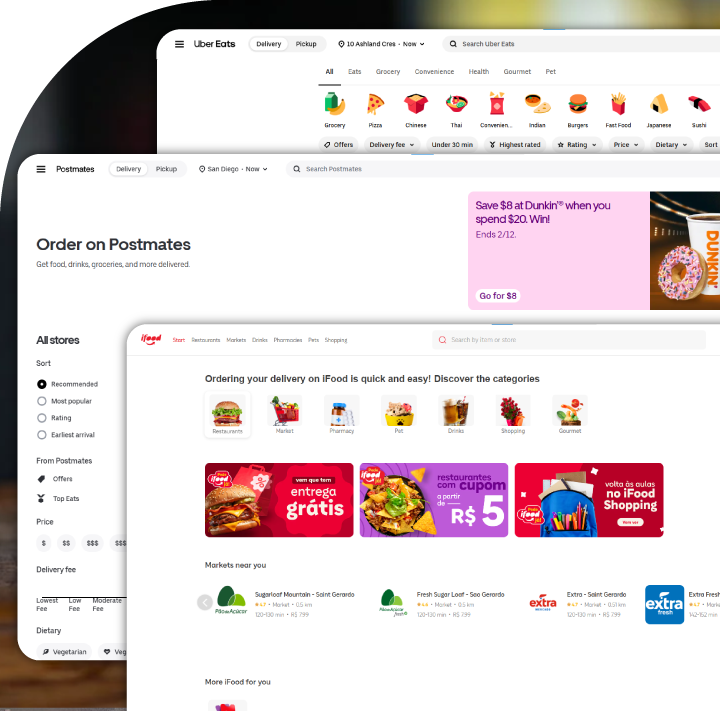Introduction
The food delivery market has undergone a total transformation with the emergence of digital
platforms like Uber Eats, Postmates, and iFood. All these companies connect customers to
diverse restaurants available in the market. This modern food service ecosystem portrays convenience and a wide variety, giving importance to businesses and enhancing their
understanding of dynamics.
Access to Food Delivery Data Scraping Services enables organizations to extract critical
information, including pricing strategy, customer preference, and operational efficiency.
Scraping Food Delivery Platforms like Uber Eats, Postmates, and iFood thus helps
companies know the trends and how they can optimize their offerings and make fine-tuned
marketing.
This report delves into Web Scraping the food delivery sites, including Uber Eats, Postmates,
and iFood. It provides several effective methodologies for extracting data from them. Businesses
using this insight make data-driven decisions, enhance service quality, and maintain a strong
market presence.
Data Collection Methodology

Sources of Data
Data was systematically gathered from leading food delivery platforms through structured
methodologies to conduct a comprehensive analysis. The primary sources include:
- Uber Eats: A globally recognized food delivery service known for its extensive network of restaurant partnerships, seamless user experience, and efficient logistics. It provides valuable insights into consumer behavior, restaurant popularity, and pricing strategies.
- Postmates: A versatile platform that extends beyond food delivery, offering grocery and convenience store deliveries. As a unique player in the market, it provides critical data on consumer demand for multi-category deliveries and operational efficiencies.
- iFood: The dominant food delivery service in Latin America, particularly in Brazil, offering an extensive range of local and international cuisines. Its data reveals regional food preferences, restaurant performance metrics, and delivery trends.
This report delves into Web Data Collection from Uber Eats, Postmates, and iFood, outlining methodologies to Extract Food Delivery sites like Uber Eats, Postmates, and iFood to gain actionable business insights.
Data Points Extracted
The data extraction process focused on gathering comprehensive insights, including:
- Restaurant Details: Name, location, and type of establishment.
- Cuisine Types: Popular food categories available on the platform.
- Pricing Information: Cost of meals, variations in pricing across different platforms, and special offers or discounts.
- Delivery Fees and Times: Cost of delivery and estimated time taken for order fulfillment.
- Customer Ratings and Reviews: Consumer feedback, average ratings, and common complaints.
- Menu Details: Items offered, the popularity of certain dishes, and pricing strategies.
- Promotional Offers: Discounts, loyalty programs, and seasonal deals offered by restaurants or platforms.
Key Insights and Data Analysis

Popular Cuisines Across Platforms
A detailed comparison of cuisine preferences across Uber Eats, Postmates, and iFood highlighted significant differences in customer demand. By leveraging Web Scraping Food Delivery Data, businesses can analyze regional trends, popular cuisines, and shifting consumer preferences. Additionally, Restaurant Menu Data Scraping provides insights into pricing strategies, dish popularity, and restaurant offerings, helping businesses optimize their menus and enhance market competitiveness.
| Cuisine Type |
Uber Eats (%) |
Postmates (%) |
iFood (%) |
| Fast Food |
30 |
35 |
28 |
| Pizza |
20 |
15 |
22 |
| Asian |
15 |
10 |
18 |
| Healthy Options |
12 |
8 |
10 |
| Local/Regional |
10 |
12 |
15 |
| Desserts |
8 |
10 |
7 |
| Other Cuisines |
5 |
10 |
5 |
Observations:
- Fast food dominates across all platforms, with the highest percentage seen in Postmates.
- Pizza remains a favorite, particularly in iFood’s market, driven by regional preferences.
- Asian cuisine is highly popular on Uber Eats and iFood, reflecting urban customer demands.
- Health-conscious options are gaining traction, though they still lag behind mainstream fast food and pizza.
Pricing Insights and Variations
Analyzing the pricing structures across Uber Eats, Postmates, and iFood offers valuable insights into affordability and consumer spending patterns. Utilizing Food Delivery Scraping API Services , businesses can extract real-time pricing data to compare costs, identify trends, and optimize their strategies. Additionally, leveraging Food Delivery Intelligence Services helps understand competitive pricing, regional variations, and customer purchasing behavior, enabling businesses to refine their offerings and enhance their market positioning effectively.
| Platform |
Average Meal Price (USD) |
Average Delivery Fee (USD) |
Peak Time Surge (%) |
| Uber Eats |
12.50 |
3.99 |
20 |
| Postmates |
11.80 |
4.50 |
25 |
| iFood |
10.30 |
2.75 |
15 |
Observations:
- iFood offers the lowest meal and delivery prices, making it the most affordable option. Analyzing the iFood Food Delivery Dataset helps businesses understand regional pricing strategies and consumer spending habits.
- Uber Eats maintains moderate pricing, with slightly lower delivery fees than Postmates. Insights from the Uber Eats Food Dataset allow businesses to track menu pricing trends, promotions, and customer preferences.
- Postmates has the highest delivery fees and surge pricing, which may impact order volume during peak hours. Comparing iFood, Uber Eats, and Postmates data helps businesses adjust pricing strategies and optimize customer retention.
Delivery Time Analysis
Timely delivery is a key factor in ensuring high customer satisfaction. Through Restaurant Data Intelligence Services , businesses can analyze delivery speed, efficiency, and service reliability across Uber Eats, Postmates, and iFood. By integrating insights from a Food Price Dashboard , companies can assess how delivery times impact pricing strategies and customer retention. This data-driven approach helps optimize logistics, improve service standards, and enhance overall customer experience in the competitive food delivery industry.
| Platform |
Average Delivery Time (Minutes) |
Peak Hour Delay (%) |
| Uber Eats |
35 |
18 |
| Postmates |
40 |
22 |
| iFood |
30 |
12 |
Observations:
- iFood has the shortest average delivery time, making it the fastest among the three platforms.
- Postmates experiences the longest delays, likely due to its extended service range and non-food deliveries.
- Uber Eats is moderately efficient, but peak-hour congestion can impact delivery speeds.
Customer Preferences and Ratings
Customer satisfaction is a key metric influencing platform success.
| Platform |
Average Rating (out of 5) |
Common Complaints |
| Uber Eats |
4.3 |
Delayed deliveries, missing items |
| Postmates |
4.0 |
High fees, inconsistent service |
| iFood |
4.5 |
Limited restaurant options |
Observations:
- iFood boasts the highest customer satisfaction, although it has fewer restaurant options.
- Uber Eats maintains a strong rating, despite occasional delivery delays.
- Postmates faces criticism due to higher costs and service inconsistencies.
Competitive Landscape and Business Implications

Market Positioning
Understanding the market positioning of significant food delivery platforms provides valuable insights into competitive dynamics and growth opportunities.
- Uber Eats: A globally dominant player with an extensive network of restaurant partnerships, Uber Eats maintains a strong presence in multiple regions. Its seamless user experience and robust logistics make it a preferred choice for customers. By Web Scraping Uber Eats Food Delivery Data, businesses can analyze restaurant listings, customer preferences, and delivery patterns to enhance market strategies.
- Postmates: Unlike traditional food delivery services, Postmates offers a broader range of deliveries, including groceries and convenience store items. However, it faces increasing competition from specialized grocery and retail delivery platforms. By leveraging Web Scraping Postmates Food Delivery Data, businesses can track product availability, pricing trends, and delivery efficiency to refine their service offerings.
- iFood: As the market leader in Latin America, iFood focuses on affordability and fast deliveries, making it a dominant player in Brazil and beyond. By collecting data through Postmates Food Delivery Scraping API Services, companies can compare service efficiencies, pricing strategies, and regional preferences to optimize their operations.
Business Impact
The competitive landscape of food delivery platforms requires businesses to adapt and implement data-driven strategies to stay ahead.
- Dynamic Pricing Models: Restaurants must adjust pricing strategies based on demand, competition, and consumer behavior. Using Uber Eats Food Delivery Scraping API Services, businesses can monitor price fluctuations and optimize menu pricing for maximum profitability.
- Promotions and Discounts: Offering special deals and loyalty incentives increases engagement and repeat orders. Insights from Ifood Food Delivery Scraping API Services help businesses identify trends in promotions and consumer spending habits to create targeted marketing campaigns.
- Efficient Delivery Logistics: Fast and reliable delivery enhances customer satisfaction and retention. By analyzing Uber Eats and Postmates delivery data, businesses can improve route optimization, delivery speed, and overall operational efficiency.
By leveraging advanced food delivery data scraping techniques, businesses can gain a competitive edge, refine their strategies, and enhance customer experience in the evolving food delivery industry.
Conclusion
Data scraping from food delivery platforms offers critical insights into pricing strategies, consumer behavior, and delivery efficiency. Utilizing iFood Restaurant Data Scraping, businesses can analyze menu trends, regional demand, and restaurant performance to refine their market strategies. Similarly, extracting a Food and Restaurant Items Dataset from Postmates enables companies to assess product availability, pricing variations, and consumer purchasing patterns.
Future trends in the food delivery industry indicate a shift towards:
- AI-driven pricing and personalized recommendations, enhancing customer engagement.
- Autonomous delivery solutions, including drones and robots, improve speed and efficiency.
- Sustainability initiatives like eco-friendly packaging and carbon-neutral deliveries align with environmental goals.
By leveraging data-driven insights from iFood, Postmates, and Uber Eats, businesses can optimize operations, improve customer experiences, and maintain a competitive edge in the rapidly evolving food delivery landscape.
If you are seeking for a reliable data scraping services, Food Data Scrape is at your service. We hold prominence in Food Data Aggregator and Mobile Restaurant App Scraping with impeccable data analysis for strategic decision-making.























































































